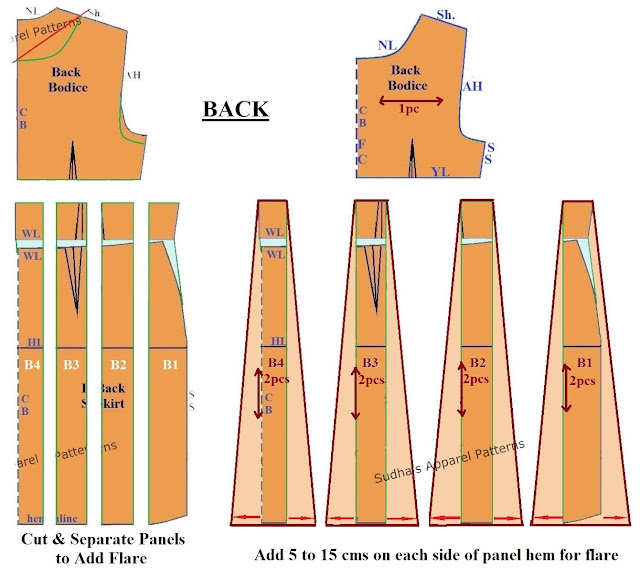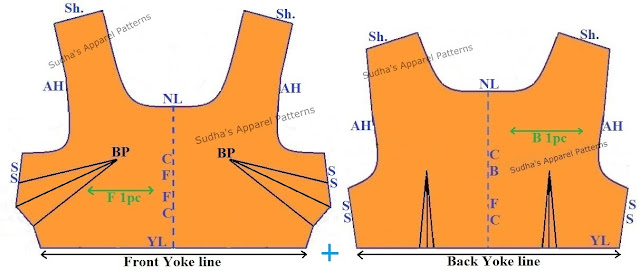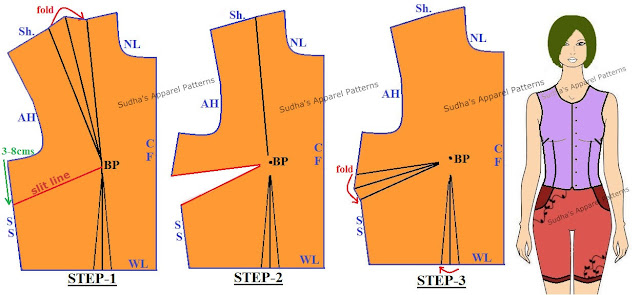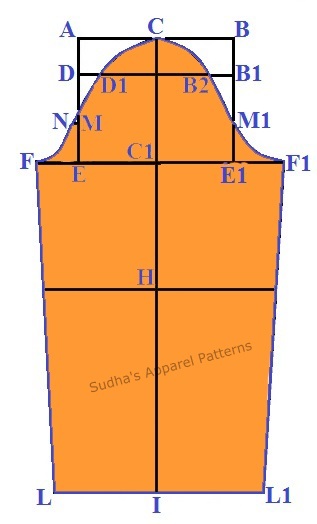In my previous post, I had shown pattern making of Circular Skirt Anarkalis and its variations.
In this post, I will show step-wise pattern making of Single Piece Anarkali & Panel Anarkali with its variations.
* The pictures and instructions are offered here for free. Please don't repost any of my content without permission. Thanks!
SINGLE PIECE ANARKALI
Though the name suggests single piece, you can have a variation by adding yokes & flare to this dress. I will be showing the draft with only flare. For this pattern we need -
1. Step-3 of Front Bodice (with side seam oblique dart & waist dart) from Basic Dart Manipulations in Women's wear {Two Darts}
2. Back Bodice (with waist dart) from Women's wear Basic Bodice {till waist} [Front & Back].
2. Back Bodice (with waist dart) from Women's wear Basic Bodice {till waist} [Front & Back].
3. Basic Skirt with waist darts (Front & Back).
- Trace Front Bodice with side seam oblique dart & waist dart. Below this bodice, trace Front of basic skirt draft. Similarly, trace Back Bodice with waist dart & below that bodice, trace Back of basic skirt.
 |
| How to make Single Piece Anarkali? |
- For flare, move outwards from hemline by 5 to 15 cms. depending on how much flare is required.
- Using a scale move up towards hip line, join this flare point to hip curve (i.e. merge slant line into curve).
- At the hem and side seam corner, move up on slant line by 2cms (see image) and give a slight curve shaping to the hem.
- Also make Basic Sleeve pattern, and further modify the length of sleeve as required.
- Also make Basic Sleeve pattern, and further modify the length of sleeve as required.
PANEL ANARKALI
There are 3 variations in Panel Anarkali -
(1) Half panel, (2) Full (lengthwise) Panel & (3) Horizontal Panel.
(1) Half Panel Anarkali Dress:-
- This pattern has vertical panels running below front and back yokes.
- This pattern has vertical panels running below front and back yokes.
For Half Panel Anarkali, we need to make paper pattern of:-
a) Anarkali Front Yoke
b) Anarkali Back Yoke
c) Panels of Anarkali
d) Sleeve
- For making Yoke of Half Panel Anarkali, trace Front bodice with its darts from Basic Bodice Sloper (till waist) [Front & Back] made with personal body measurements.
b) Anarkali Back Yoke
c) Panels of Anarkali
d) Sleeve
- For making Yoke of Half Panel Anarkali, trace Front bodice with its darts from Basic Bodice Sloper (till waist) [Front & Back] made with personal body measurements.
- Transfer only shoulder dart of Front bodice to side seam oblique dart. * To learn stepwise transfer of shoulder dart to side seam oblique dart, refer "Basic Dart Manipulations in Women's wear (two darts)".
- Trace Front with side seam oblique dart & waist dart (i.e. Step-3 of basic dart manipulations). Below this bodice, trace Front of basic skirt draft.
 |
| How to make Half Panel Anarkali? |
- Similarly, trace Back Bodice with waist dart from Basic Bodice Sloper (till waist) [Front & Back] & below that bodice, trace Back of basic skirt.
- For how to do Neckline Shaping, Armhole Deepening and Yokeline Marking of Anarkali Yokes (Front & Back), you can refer Anarkalis (Part-1)- Circular skirt & its variations.
- Length of the Anarkali panels can be extended straight down below knee (i.e. hemline) as required.
- For how to do Neckline Shaping, Armhole Deepening and Yokeline Marking of Anarkali Yokes (Front & Back), you can refer Anarkalis (Part-1)- Circular skirt & its variations.
- Length of the Anarkali panels can be extended straight down below knee (i.e. hemline) as required.
- Divide the yoke line of Front and Back as per number of panels required. I have divided the yoke line in 4 parts, so I will get total of 8 panels in front & 8 at back.
# Some Tip: Marking each panel is necessary to avoid confusion later on when panels are cut.
- I have marked each panel as B1, B2, B3, B4 (for Back panels) & F1, F2, F3, F4 (for Front panels).
 |
| How to make Half Panel Anarkali? |
 |
| How to make Half Panel Anarkali? |
- These panels are straight. For Anarkali dress, we need to add flare to each panel of Front & Back.
- Hence, once you number each of these panels; cut, place and trace them on a separate paper to add required flare (see above image).
- For adding flare, extend hem of each panel towards its left & right side by 5 to 15 cms.
# Some Tip: Work on one panel extension at a time.
- Once you extend the hem on either sides of each panel, join extended hemline (using scale) in a slant line moving upwards at top of panel (see above image).
- With the same method, add flare to each of the front & back panels.
- Final panels of Front and Back of Anarkali dress are marked in Maroon color.
- Also make Basic Sleeve pattern, and further modify the length of sleeve as required.
- Also make Basic Sleeve pattern, and further modify the length of sleeve as required.
(2) Full Panel (Lengthwise) Anarkali:-
- For full panel Anarkali (i.e. lengthwise panels), trace Front bodice with side seam oblique and waist darts & below this bodice, trace front basic skirt draft (see below image).
 |
| How to make Full (Lengthwise) Panel Anarkali? |
- Measure & divide the chest line, waist line and hem line in equal parts.
- Draw straight green lines starting from neck, shoulder and armhole towards hem line (refer image).
# Some Tip: Marking each panel is necessary to avoid confusion later on when panels are cut.
- These panels are straight (except the panel with side seam) and for Anarkali dress, we need to add flare to each of these panels of Front & Back.
- Once you number each of these panels; cut, place & trace them on a separate paper to add required flare (see image).
- For adding flare, extend hem of each panel towards its left & right side by 5 to 15 cms.
# Some Tip: Work on one panel extension at a time.
- Extend the hem on either sides of each panel and join the extended line in a slant line (using scale) moving up towards the waist line (refer image).
- With the same method, add flare to each of the Front and Back panels.
- Final panels of Front and Back of Anarkali dress are marked in Maroon color.
- Also make Basic Sleeve pattern, and further modify the length of sleeve as required.
- Also make Basic Sleeve pattern, and further modify the length of sleeve as required.
(3) Horizontal Panel / Tier Anarkali Dress:-
- This pattern has horizontal panels running below front and back yokes.
For Horizontal Panel Anarkali, we need to make paper pattern of:-
a) Anarkali Front Yoke b) Anarkali Back Yoke c) Panels of Anarkali d) Sleeve
- For making Yoke of Horizontal Panel Anarkali, trace the Front bodice draft having shoulder, neckline, armhole, side seam, waist line and its two darts i.e. shoulder & waist dart. [Refer Basic Bodice Sloper for tracing Front]
- For making Yoke of Horizontal Panel Anarkali, trace the Front bodice draft having shoulder, neckline, armhole, side seam, waist line and its two darts i.e. shoulder & waist dart. [Refer Basic Bodice Sloper for tracing Front]
- For making the Anarkali yokes, we have to transfer these 2 darts (i.e. shoulder & waist dart) to side seam oblique dart. * To learn stepwise transfer of these darts to side seam oblique dart, refer "Basic Dart Manipulation in Women's wear"
- Take Front with side seam oblique dart (i.e. Step-5 of basic dart manipulations) & further alter it step-wise for Neckline Shaping, Armhole Deepening and Yokeline Marking of Anarkali Yokes (Front & Back), [Refer Circular Skirt Anarkalis and its variations.]
Panel Width (How to calculate?):-
- When calculating width of each panel, calculate for both front & back panels together and then divide each panel lengthwise into half for attaching it to front and back yoke separately.
- For example; If Round Waist is 30" then Panel-1 will be 30" x 1.5 = 45". This 45" width will be cut lengthwise & separated into half, where one part will be attached below front yoke & other part will be attached to back yoke.
- For every next Panel, add 20" to 30" to total width of previous panel depending on required flare.
- For example; If Panel-1 = 45" then Panel-2 = 45" + 20" to 30". Since, I am adding 20", my panel calculation is as follows:-
 |
| How to make Horizontal Panel / Tier Anarkali? |
Panel Length (How to calculate?):-
- Length of the Horizontal Anarkali dress, should be calculated from below yoke line till either knee or below knee or till floor.
- For example; I have measured the length as 40" (from below yoke line) and I have 5 horizontal panels. So I will use the formula as 1/5th of length i.e. 40"/ 5 = 8".
- Hence, the length of each panel (without seam allowance) will be 8".
- These panels can vary in its width and length depending on the total available yardage.
- Also make Basic Sleeve pattern, and further modify the length of sleeve as required.
- Also make Basic Sleeve pattern, and further modify the length of sleeve as required.
------------------------------
I hope this post was helpful to you.
I hope this post was helpful to you.





















